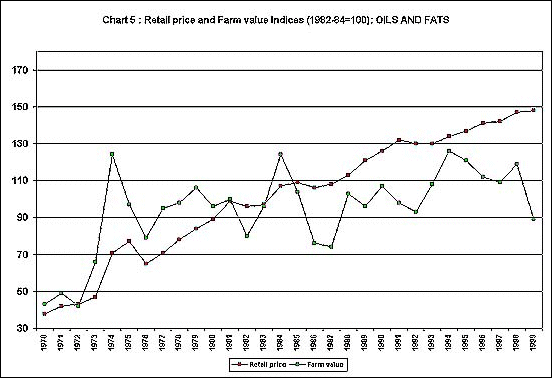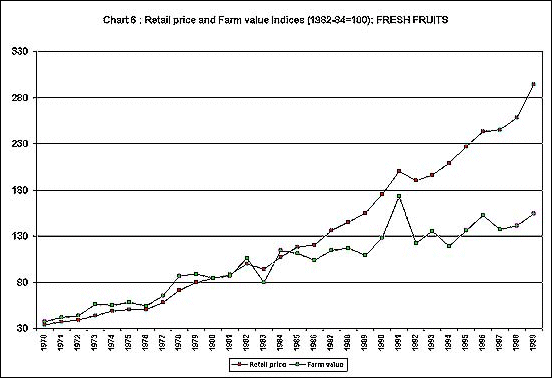|
While
these figures are cited in current dollars, the story
is similar when they are adjusted for inflation. Between
1990 and 1999, marketing costs rose 14 percent, while
consumer food expenditures climbed 8 percent in real
dollar terms. Meanwhile, the farm value of food purchases
dropped 11 percent.
Most mainstream analysts
have attributed this to shifting tastes and patterns
of demand, reflecting not only Engels Curve type changes
but also changing work participation rates of women.
Thus, consumers bought a larger volume of food, value-added
processing and packaging of at-home foods increased,
spending at restaurants and fast food outlets grew,
and prices for marketing inputs rose. A changing workforce
— comprising more working women and more two-income
households — meant that busy consumers of the 1990's
demanded quick, easy-to-prepare convenience foods. The
strong economy of the late 1990's raised incomes and
allowed more consumers to pay for highly processed convenience
foods.
It is typically suggested that all of these factors
were the dominant contributors to the jump in food spending
during the 1990's. Certainly, they played a role, but
there were other important changes in production organisation
which were probably even more significant. This is discussed
in more detail below, after a look at the detailed trends.
A look at the more disaggregated data shows that this
broad tendency of divergence between farm values and
retail prices is evident in all the major food subsectors.
Charts 2-9 show the index numbers of constant price
trends of retail and values received by farmers for
a wide range of food subsectors. These charts are very
instructive.
Consider the case of meat products, shown in Chart 2.
Until the mid-1980s, not only did the two indices move
together, but farm value changes tended to be more than
retail prices. From 1986 onwards, that pattern has been
reversed. And from 1990, farm values have been declining
quite sharply even as retail prices have continued to
rise. By the late 1990s, the gap between the two was
enormous.

Chart
2 >> Click
to Enlarge

Chart
3 >> Click
to Enlarge

Chart
4 >> Click
to Enlarge
Very similar trends are evident for poultry (Chart 3)
and for dairy products (Chart 4), the only difference
being that in the 1990s in these two subsectors farm
values do not decline as in meat products, but remain
broadly stagnant. Similarly for fresh fruits (Chart
6) and fresh vegetables (Chart 7). However, the point
about the latter two is that there is less scope for
further and further processing in these, and therefore
the discrepancy between retail price and farm value
may be more reflective of increases in marketing margins
rather than actual changes in the degree of processing.

Chart
5 >> Click
to Enlarge

Chart
6 >> Click
to Enlarge

Chart
7 >> Click
to Enlarge
|

